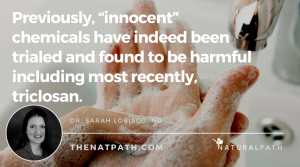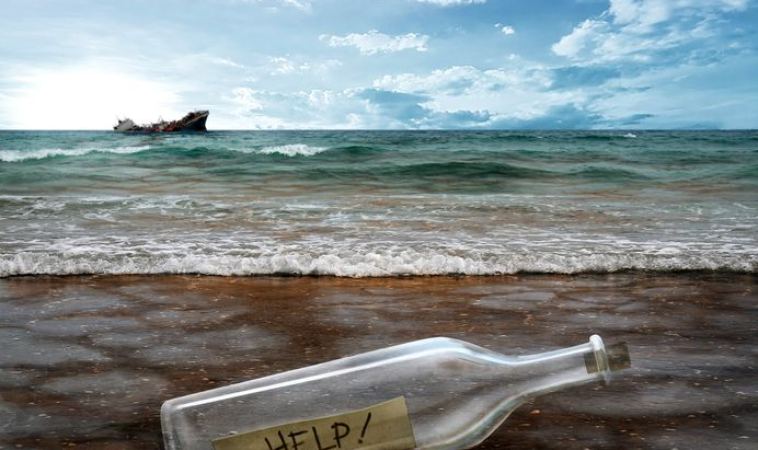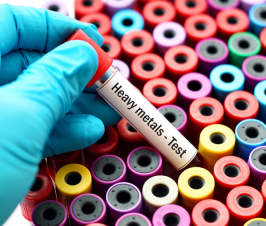Buyer Beware: Why we aren’t being “Protected” by our Government (Part II)
 In part I, I discussed the dirty little secret of our toxic environment, why this has health experts concerned, and provided resources for mitigating the effects of harmful exposures.
In part I, I discussed the dirty little secret of our toxic environment, why this has health experts concerned, and provided resources for mitigating the effects of harmful exposures.
Now, I want to show you why this secret was not well known and why we aren’t being “protected” by our government. I’ll also discuss briefly a very simple thing you can do every day to make a difference and start turning the tide to a less-toxic world.
Why There’s Truly NO “Safe Oversight”
If you think your personal care and household products are tested for safety before you buy them and you live in the United States, you are wrong. According to the FDA website:
Neither the law nor FDA regulations require specific tests to demonstrate the safetyof individual products or ingredients. The law also does not require cosmetic companies to share their safety information with FDA.
… FDA is not authorized to order recallsof cosmetics, but we do monitor companies that conduct a product recall and may request a product recall if the firm is not willing to remove dangerous products from the market without FDA’s written request.1
This means that things being released into the market in convenient, pretty bow-tied packages have aesthetic or pocketbook appeal, but aren’t necessarily proven to be safe, much less healthy. (For more details on this, please see Part I.)
You may be wondering, “If a government agency isn’t requiring oversight of safety of these products, how are consumers protected?”
Ahh, that’s the problem. Many of the products on the market are deemed safe until proven harmful.
According to a 2005 study in the Journal of the American Academy of Dermatology, the Cosmetic Ingredient Review (CIR) was formed in 1976 by the Cosmetics, Toiletry, and Fragrance Association. The role of the CIR is to perform independent, expert reviews to determine the safety of ingredients found in cosmetics. The CIR staff base their monograph safety summaries on available and requested data, as well as public comments, and submit them to publication in the International Journal of Toxicology.
Of the 1194 ingredients said to be addressed, many ingredients’ safety assessments had specific qualifications, insufficient data, or were nonconclusive based on synergistic ingredients and conflicting studies. The abstract states:
Of these, 683 were found to be safe in cosmetics in the present practices of use and concentration. With qualifications, another 388 have been found safe for use in cosmetics; specific qualifications for each are given. Nine ingredients have been deemed unsafe for use in cosmetics and the safety issue has been described. The available data were found insufficient to support the safety of 114 ingredients; the needed data are listed. Hair dyes represent an important product category reviewed by CIR. In considering hair dyes, the CIR Expert Panel reviews experimental and clinical data specific to the particular chemical structure of each hair dye and reviews epidemiologic studies that address hair dye use that are less specific. Recently the CIR Expert Panel concluded that the available epidemiologic studies are insufficient to conclude there is a causal relationship between hair dye use and cancer and other end points. 2
But, as far as chemicals, is innocent until proven guilty a good strategy?
The same article continues:
It is inevitable that new information will become available concerning ingredients for which safety assessments were completed in the early days of the program. To consider new data, the CIR Expert Panel has instituted a re-review program. Sodium lauryl sulfate (SLS), formaldehyde, and parabens are discussed as examples. 2
Previously, “innocent” chemicals have indeed been trialed and found to be harmful3-13 including most recently, triclosan.4 Furthermore, more current research is indicating stronger and stronger connections between hair dyes and human health risks.5-7
These facts have caused the Campaign for Safe Cosmetics and many concerned consumer groups to argue that the CIR is not a solution to safeguarding our health.3,8 The Campaign for Safe Cosmetics reports on their website:
In the absence of government authority, the safety of personal care product ingredients is evaluated through a voluntary industry program known as the Cosmetic Ingredient Review process. Not only is this program run by the very industry it is intended to oversee, but compliance with CIR recommendations is totally voluntary. The CIR has reviewed less than 20% of the FDA estimated 12,500 chemicals used in cosmetics, and of those the CIR has reviewed, they have found only 9 chemicals unsafe for use in cosmetics. What safety data does exist focuses on acute reactions to products, such as skin rashes or allergic reactions, as opposed to studies that look at chronic health effects from chemicals in personal care products, like cancer, reproductive or nervous system effect that are driven by genetic susceptibility, the timing of exposure, and aggregate exposures over a lifetime.3
The Toxic Tide May Be Turning, but Is It Enough?
Thankfully, some representatives in our government have been taking notice of the need for more regulation. There was a recent proposal to update this over 70-year-old safety bill, the Senate Personal Care Product Safety Act of 2015.3,9-10,12 This would allow more regulation of the FDA by:
- Directing the FDA to assess the safety of a minimum of five cosmetics chemicals a year;
- Requiring companies to register their facilities, products and ingredients with the FDA;
- Requiring companies to comply with good manufacturing practices;
- Closing labeling loopholes by requiring full ingredient disclosure for professional salon products and web-based sales of cosmetic products; and
- Giving the FDA mandatory recall authority to get unsafe products off the shelves.3,-10,12
- Minimizing animal testing 10
- Providing financial overviews of how this could be accomplished within the industry. 10
Still, there are gaps that many feel need to be filled.3,9,12 According to the Campaign for Safe Cosmetics, further strengthening amendments are required and need to be addressed in several areas:
- The bill’s weak safety standards
- Industry self-certification stringency and unbiased appraisal
- Reporting of fragrance ingredients
- Sharing of safety studies to the FDA
- Providing consumers with information on potential adverse reactions
- Removing of Federal preemption
Where Are We Now?
So, the good news is the word is getting out nationally to the Federal government. However, even with these amendments, the bill would still place the U.S. pitifully behind other European and international standards which are more stringent. 3,11-12
For example, here are just a few examples of their long list of regulations required by the European Union (EU):
| (16) | To ensure their safety, cosmetic products placed on the market should be produced according to good manufacturing practice. |
| (17) | For the purpose of effective market surveillance, a product information file should be made readily accessible, at one single address within the Community, to the competent authority of the Member State where the file is located. |
| (18) | In order to be comparable and of high quality, the results of the non-clinical safety studies carried out for the purposes of assessing the safety of a cosmetic product should comply with the relevant Community legislation. |
| (19) | It should be made clear which information is to be made available to the competent authorities. That information should include all the necessary particulars relating to identity, quality, safety for human health and the effects claimed for the cosmetic product. In particular, this product information should include a cosmetic product safety report documenting that a safety assessment has been conducted. |
| (20) | To ensure the uniform application and control of the restrictions for substances, sampling and analysis should be carried out in a reproducible and standardised manner.11 |
…There are 71 regulations in total, followed by more chapters and details of these requirements. If you want, you can read them here.
The Campaign for Safe Cosmetics summarizes these provisions in only a few paragraphs as compared to the United States:
The European Union, now 28 countries strong, has more stringent and protective laws for cosmetics than the United States. The hazard-based, precautionary approach of the EU acknowledges that chemicals linked to cancer and birth defects simply don’t belong in cosmetics – regardless of the concentration of the chemical being used.
The United States has much to learn from the EU example. The EU Cosmetics Directive (76/768/EEC) was adopted in January 2003and most recently revised in2013. The EU law bans 1,328 chemicals from cosmetics that are known or suspected to cause cancer, genetic mutation, reproductive harm or birth defects. In comparison, the U.S. FDA has only banned or restricted 11 chemicals from cosmetics. Unlike the United States, EU law requires pre-market safety assessments of cosmetics, mandatory registration of cosmetic products, government authorization for the use of nanomaterials and prohibits animal testing for cosmetic purposes.12
How You Are Already, or Can Be, Casting a Vote for a Safer, Healthier World Everyday
As one who believes in the precautionary principle,13 I support my clients in finding safe, natural substances that are not harmful to our bodies and the environment.
The good news is, by caring about our health and choosing products that don’t cause us harm, we are paving the way for a cleaner and healthier world.
In fact, many of us are involved in a political act everyday…with our purchase decisions. Like it or not, with a simple click or stop at the market, you and your family are casting votes. Every time you pull out your pocketbook, you are communicating in the language that speaks volumes to manufactures about what their consumers want. Cold-hard-cash! This means, they will make more of the “good stuff,” and less of the bad!
And, the movement is spreading:
Data shows consumers reward sustainable brands
According to our research, 57 percent of shoppers have made a purchase in the past year because of a retailer’s commitment to sustainability. More than half of Americans are inspired to choose green retailers, and 75 percent say they do so now more than they did five years ago.
Interestingly, consumers don’t have lofty beliefs that a single purchase really impacts the environment. Rather, they put stock in the potential impact a brand’s commitment to sustainability can have at scale. Sixty-two percent explain that they shop at sustainable brands to reward and support companies who are aligned with their own values. For example, a consumer might shop at Patagonia, not because she thinks buying that pullover fleece will help save the planet, but because she wants to support a brand that shares her green values, and propagates them with their business.
Therefore, if you want to get “involved,” spread the word about these dirty little secrets and empower everyone you know to make more informed decisions on how to cash-in on the movement.
My family and I choose to purchase most of our products from a company that does value sustainability, quality, and chemical-free healthy living.
Image Copyright: <a href=’https://www.123rf.com/profile_jordygraph’>jordygraph / 123RF Stock Photo</a>
References
- S. Food and Drug Administration (FDA). FDA Authority Over Cosmetics: How Cosmetics Are Not FDA-Approved, but Are FDA-Regulated. FDA.gov. Updated August 3, 2013. https://www.fda.gov/Cosmetics/GuidanceRegulation/LawsRegulations/ucm074162.htm#Does_FDA_approve/
- Bergfeld WF, Belsito DV, Marks JG Jr, Andersen FA. Safety of ingredients used in cosmetics [abstract]. J Am Acad Dermato [online]l. 2005 Jan;52(1):125-32. Available at: https://www.ncbi.nlm.nih.gov/pubmed/15627090
- Campaign for Safe Cosmetics. US Laws: Senate Personal Care Product Safety Act of 2015. Safecosmetics.org. http://www.safecosmetics.org/get-the-facts/regulations/us-laws/#sthash.9aXZ1484.dpuf
- S. Food and Drug Administration (FDA). 5 Things to Know About Triclosan. FDA.gov. updated September 2, 2016. https://www.fda.gov/ForConsumers/ConsumerUpdates/ucm205999.htm
- Dotinga, R. Could Certain Hair Dyes, Relaxers Raise Breast Cancer Risk? Consumer Health Day. June 20, 2017. https://consumer.healthday.com/cancer-information-5/breast-cancer-news-94/could-certain-hair-dyes-relaxers-raise-breast-cancer-risk-723833.html
- Nohynek GJ, Fautz R, benech-Kieffer F, Toutain H. Toxicity and human health risk of hair dyes: Review. Food and Chemical Toxicology. 2004; 42: 517–543. Available at: https://www.researchgate.net/publication/5332277_Toxicity_and_human_health_risk_of_hair_dyes
- Heikkinen S, Pitkäniemi J, Sarkeala T, Malila N, Koskenvuo M (2015) Does Hair Dye Use Increase the Risk of Breast Cancer? A Population-Based Case-Control Study of Finnish Women. PLoS ONE.2015;10(8): e0135190. https://doi.org/10.1371/journal.pone.0135190. (used Odds ratio)
- Environmental Working Group (EWG). Cosmetics. http://www.ewg.org/key-issues/consumer-products/cosmetics
- Faber S. Cosmetics Safety Bill Gains Support from Industry and Advocates. EWG.org. July 5, 2017. http://www.ewg.org/enviroblog/2016/02/cosmetics-safety-bill-gains-support-industry-and-advocates
- 1014 – Personal Care Products Safety Act114th Congress (2015-2016). Available at: https://www.congress.gov/bill/114th-congress/senate-bill/1014/text
- REGULATION (EC) No 1223/2009 OF THE EUROPEAN PARLIAMENT AND OF THE COUNCIL of 30 November 2009 on cosmetic products. Official Journal of European Union. Available at: http://eur-lex.europa.eu/legal-content/EN/TXT/?uri=CELEX:32009R1223Hair dye continuing to “add up” for example estimating risk in 2004 to 2015 with more information.
- Campaign for Safe Cosmetics. International Laws. http://www.safecosmetics.org/get-the-facts/regulations/international-laws/
- Grandjean P, Bailar JC, Gee D, Needleman HL, et al. Implications of the Precautionary Principle in research and policy-making [abstract].Am J Ind Med [online]. 2004 Apr;45(4):382-5. Available at: https://www.ncbi.nlm.nih.gov/pubmed/15029572
- Summers, L. Think Tank: Why Consumers Vote With Their Wallets. WWD.com. July 3, 2017. http://wwd.com/business-news/business-features/larisa-summers-think-tank-10936880/
 Sarah Lobisco, ND, is a graduate of the University of Bridgeport’s College of Naturopathic Medicine (UBCNM). She is licensed in Vermont as a naturopathic doctor and holds a Bachelor of Psychology from State University of New York at Geneseo.
Sarah Lobisco, ND, is a graduate of the University of Bridgeport’s College of Naturopathic Medicine (UBCNM). She is licensed in Vermont as a naturopathic doctor and holds a Bachelor of Psychology from State University of New York at Geneseo.
Dr. LoBisco is a speaker on integrative health, has several publications, and has earned her certification in functional medicine. Dr. LoBisco currently incorporates her training as a naturopathic doctor and functional medicine practitioner through writing, researching, private practice, and through her independent contracting work for companies regarding supplements, nutraceuticals, essential oils, and medical foods.
Dr. LoBisco also enjoys continuing to educate and empower her readers through her blogs and social media. Her recent blog can be found at www.dr-lobisco.com.

















